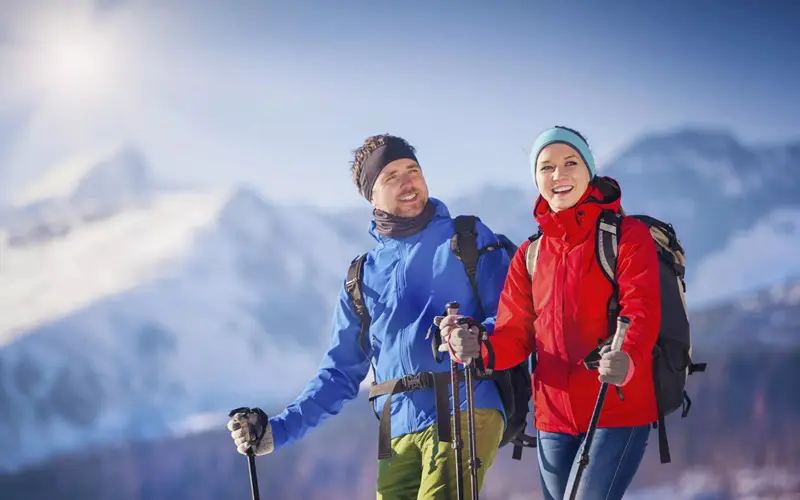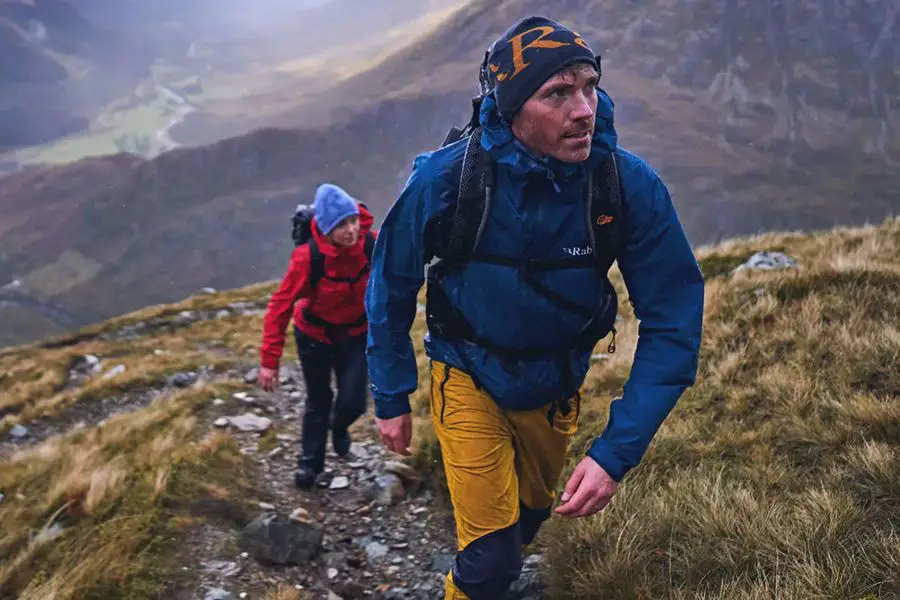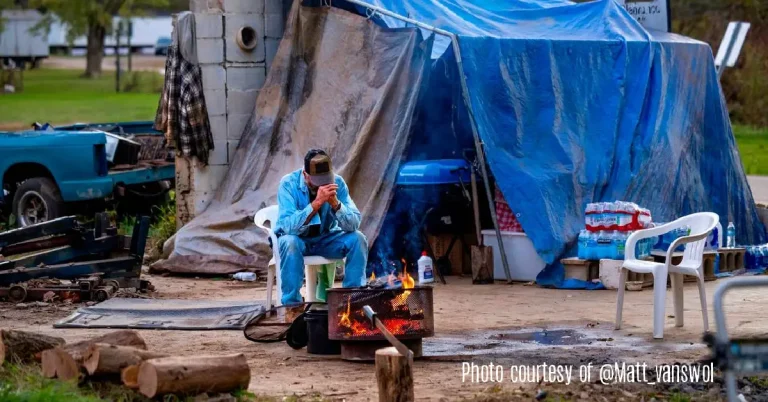SHTFPreparedness may collect a share of sales or other compensation from the links on this page.
These days, there is a general consensus among outdoor enthusiasts that the most effective way to stay warm, dry, and comfortable while hiking is to use the layering system.
However, when it comes to the specifics of how to properly layer, many people tend to get a little fuzzy on the details.
We aim to clear up any confusion with a straight-talking, no-nonsense guide on how to dress in layers with eight expert tips.
How to Use the Layering System Effectively

Cotton fabrics can hold up to a whopping 27 times their weight in water.
While this may not seem like such an egregious issue at first glance, it becomes so when we consider that water can also conduct heat away from the body 25 times faster than air.
Therefore, if we happen to get wet or work up a sweat while hiking, those cotton garments quickly become a serious health hazard.
Hypothermia is a very real possibility should the temperature drop even a few degrees or if we stop for a long enough period of time for our body temperature to significantly drop.
1. Know Your Layers
Each layer of clothing has an important role to play in the overall efficiency of the layering system.
Knowing what these parts are can help you choose your layers more carefully, both when buying and when it comes to selecting your outfit for any given outing in different conditions or for different types of activities.
Base Layer
The layering system’s innermost layer is all about moisture management.
In short, this layer transports (“wicks”) moisture away from your body and onto the exterior of the fabric, where it can then evaporate in the ambient air or wick through subsequent layers.
Different types of baselayer offer varying degrees of moisture control, but the best materials are merino wool and high-wicking synthetics.
The biggest advantages of merino wool are that it wicks very well, retains heat even when wet, and offers much more in the way of odor control than most synthetic materials.
Mid Layer
Mid layers come in a variety of fabrics—softshell, fleece, down, and wool—but share the same purpose in the layering system as a whole: insulation.
Just how beefy a midlayer you need will depend largely on the conditions and time of year you’re hiking, as well as whether or not you are wearing a shell layer on top.
But, again, the most important feature to look for in any mid layer garment is breathability.
Shell Layer
Hiking in dry and relatively windless conditions may necessitate skipping this layer, which focuses on weather protection.
Even though people often view this layer as a “backup” measure, it’s crucial to make sure your waterproofs are both highly breathable and offer adequate weather protection.
Therefore, when buying your shell layer, look for jackets and pants with a waterproof-breathable membrane that features as high a breathability rating as possible.
2. Less is More
It may seem a little counterintuitive to some, but wearing thinner layers instead of bulky ones is far more effective in keeping you warm, dry, and regulating body heat.
One common misconception among many outdoorsmen is that a beefy mid- or outer layer will do the trick when it comes to keeping us warm and protected from the elements.
Not working up a sweat may be true, but doing anything even slightly aerobic will make all that bulk a liability. Essentially, insulating layers function by trapping the warmth our bodies produce within the garment, rather than actively producing heat.
In this regard, a trio of thinner layers can outperform a single, thick mid layer (such as a puffy down jacket) by creating air pockets between the layers that hold enough body heat to keep you warm without restricting breathability.
3. Effective Fabrics
Breathability is the gold standard by which all garments are measured to gauge their effectiveness in any layering system.
Whether choosing a baselayer, midlayer, shell layer, or even just a pair of boxers or a sports bra, look for high-wicking and highly breathable materials.
These will enable your garment to “wick” sweat away from your body, transferring it from inside to outside as a vapor, rather than allowing it to accumulate on the interior of the garment.
With regard to layering, the bottom line is that breathability is required across the board—if one item in your setup is a shoddy performer in this respect, then the whole system will fail.
4. Seasonal Considerations
Some newcomers to the layering system are apt to think that it may be fine and helpful for outings in colder weather, but not much use or totally irrelevant when temperatures are high.
On the contrary, for seasonal temperature variations, all we need to do is tweak our setup with a little bit of fine-tuning.
Most baselayers and midlayers come in a variety of “weights” (typically 100–400), which refers, in essence, to their thickness and insulating capacity.
When variations in conditions call for a little less or a little more warmth for your clothing, simply adapt your layers to suit by choosing lighter or heavier garments.
5. At Camp
A simple rule that will ensure your layering system remains effective even when inactive is to throw on an extra layer as soon as you stop moving.
We are never more susceptible to a dose of chills or even hypothermia than when we’ve just finished any aerobic activity, and once our core temperature drops, it can be very difficult to get it back up again.
By making a habit of putting that extra layer on whenever we’re not on the move, we’ll be sparing ourselves the possibility of a shivery night in the tent or catching a chill.
6. Change of Clothes
While getting wet while hiking isn’t always disastrous, any moisture that soaks into our clothing can quickly lead to disaster if we stop moving for an extended period of time and allow our core temperature to drop.
As a result, the best policy is to nip the potential problem in the bud by carrying a change of clothes in your backpack and switching wet or damp items for dry ones as soon as possible.
7. Use You Clothing’s Built-In A/C
If hiking with a shell layer on, things can get a little steamy under the collar. To keep yourself cool, ensure there’s adequate airflow between your layers, and avoid having to take layers on and off throughout the day.
Use every means possible to increase ventilation without compromising your shell layer’s protection from precipitation. This might mean:
- Use your jacket’s “pit zips.”
- Unfasten the Velcro fastening on the sleeves.
- If the pockets have a mesh lining, open them.
- Adjust the waistline or hem of your shell layer and mid layer by loosening the cinch.
- Pace Yourself!
Staying sweat-free when temps are high or hiking in warm, wet conditions with a rain shell on can be a tricky business, but one simple means of doing so is to take your foot off the gas a little and slow your pace to a rate just below that at which you’re working up a sweat.
8. Take Breaks
If slowing yourself down to a snail’s pace in sticky conditions doesn’t sound like a tremendous deal of fun, another simple means of ensuring you don’t overheat or sweat excessively is to take short, frequent breaks.
Every 30-45 minutes, try to stop for no longer than two or three minutes. This duration will allow your body to cool down enough to reduce perspiration, but not so much that your muscles stiffen up or you put yourself at risk of hypothermia.
Wrap-Up
The clothing you wear when heading into the outdoors is as crucial as any other factor in contributing to your comfort levels, safety, and enjoyment of your trail time.
By getting to know and using the layering system, you’ll ensure you maximize your chances of staying dry, warm, and ailment-free, whatever the weather.
















